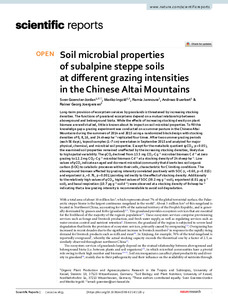| dc.date.accessioned | 2021-02-16T08:29:06Z | |
| dc.date.available | 2021-02-16T08:29:06Z | |
| dc.date.issued | 2021-01-18 | |
| dc.identifier | doi:10.17170/kobra-202101283074 | |
| dc.identifier.uri | http://hdl.handle.net/123456789/12513 | |
| dc.description.sponsorship | Gefördert durch den Publikationsfonds der Universität Kassel | ger |
| dc.language.iso | eng | eng |
| dc.rights | Namensnennung 4.0 International | * |
| dc.rights.uri | http://creativecommons.org/licenses/by/4.0/ | * |
| dc.subject | agroecology | eng |
| dc.subject | ecosystem services | eng |
| dc.subject | environmental sciences | eng |
| dc.subject | grassland ecology | eng |
| dc.subject | microbiology | eng |
| dc.subject.ddc | 570 | |
| dc.subject.ddc | 580 | |
| dc.title | Soil microbial properties of subalpine steppe soils at different grazing intensities in the Chinese Altai Mountains | eng |
| dc.type | Aufsatz | |
| dcterms.abstract | Long-term provision of ecosystem services by grasslands is threatened by increasing stocking densities. The functions of grassland ecosystems depend on a mutual relationship between aboveground and belowground biota. While the effects of increasing stocking density on plant biomass are well studied, little is known about its impact on soil microbial properties. To fill this knowledge gap a grazing experiment was conducted on a summer pasture in the Chinese Altai Mountains during the summers of 2014 and 2015 using a randomized block design with stocking densities of 0, 8, 16, and 24 sheep ha−1 replicated four times. After two summer grazing periods (each 56 days), topsoil samples (1–7 cm) were taken in September 2015 and analyzed for major physical, chemical, and microbial soil properties. Except for the metabolic quotient (qCO2; p < 0.05), the examined soil properties remained unaffected by the increasing stocking densities, likely due to high spatial variability. The qCO2 declined from 13.5 mg CO2–C g−1 microbial biomass C d−1 at zero grazing to 12.2 mg CO2–C g−1 microbial biomass C d−1 at a stocking density of 24 sheep ha−1. Low values of qCO2 indicate an aged and dormant microbial community that diverts less soil organic carbon (SOC) to catabolic processes within their cells, characteristic for C limiting conditions. The aboveground biomass affected by grazing intensity correlated positively with SOC (rs = 0.60, p = 0.015) and ergosterol (rs = 0.76, p = 0.001) pointing indirectly to the effect of stocking density. Additionally to the relatively high values of qCO2, highest values of SOC (39.2 mg g−1 soil), ergosterol (6.01 µg g−1 soil), and basal respiration (10.7 µg g−1 soil d−1) were observed at a stocking density of 8 sheep ha−1 indicating that a low grazing intensity is recommendable to avoid soil degradation. | eng |
| dcterms.accessRights | open access | |
| dcterms.creator | Gönster-Jordan, Sven | |
| dcterms.creator | Ingold, Mariko | |
| dcterms.creator | Jannoura, Ramia | |
| dcterms.creator | Bürkert, Andreas | |
| dcterms.creator | Jörgensen, Rainer Georg | |
| dc.relation.doi | doi:10.1038/s41598-021-81120-y | |
| dc.subject.swd | Agrarökologie | ger |
| dc.subject.swd | Ökosystemdienstleistung | ger |
| dc.subject.swd | Umweltwissenschaften | ger |
| dc.subject.swd | Grünland | ger |
| dc.subject.swd | Mikrobiologie | ger |
| dc.type.version | publishedVersion | |
| dcterms.source.identifier | EISSN 2045-2322 | |
| dcterms.source.journal | Scientific Reports | eng |
| dcterms.source.volume | Volume 11 | |
| kup.iskup | false | |
| dcterms.source.articlenumber | 1653 | |


